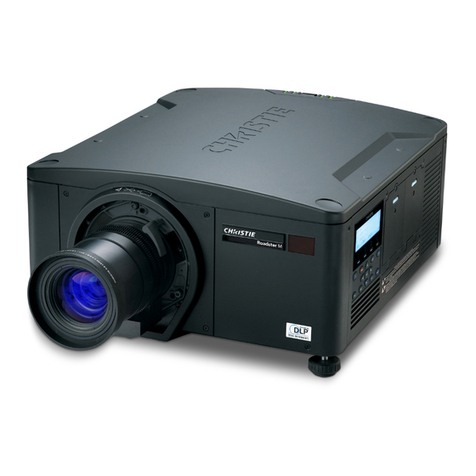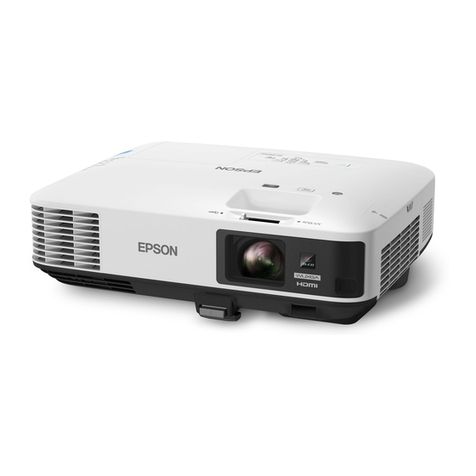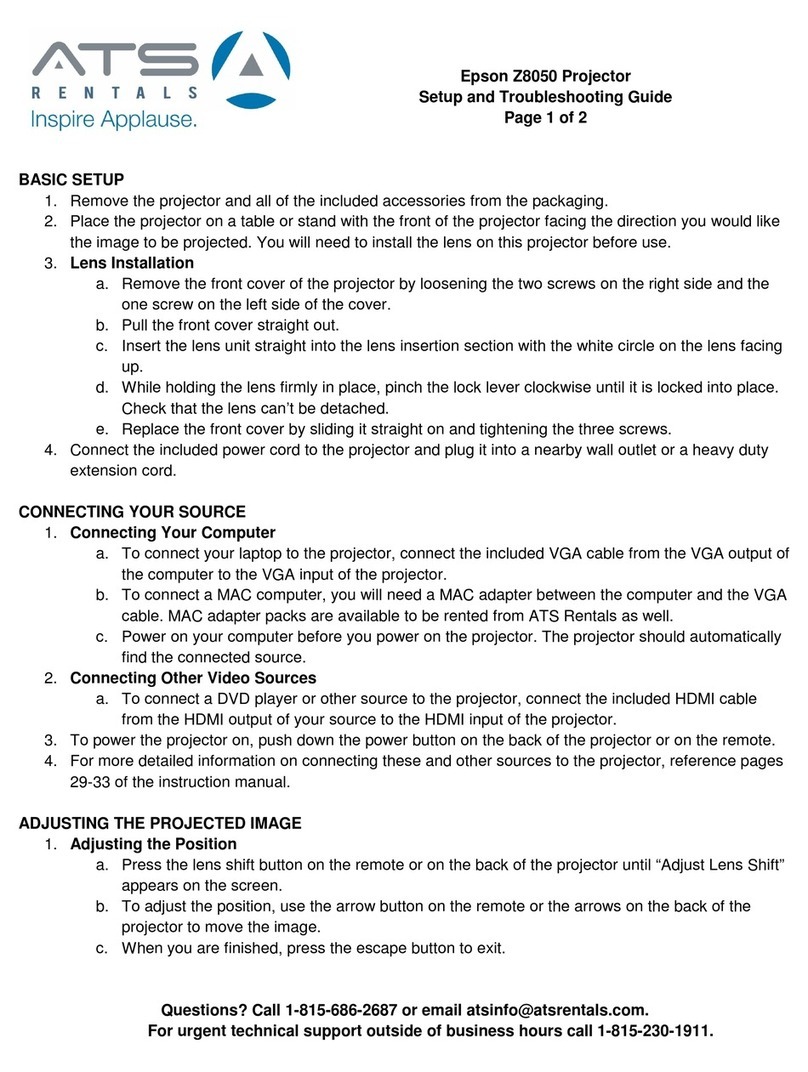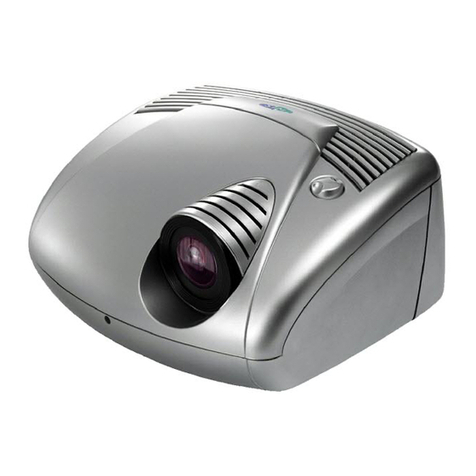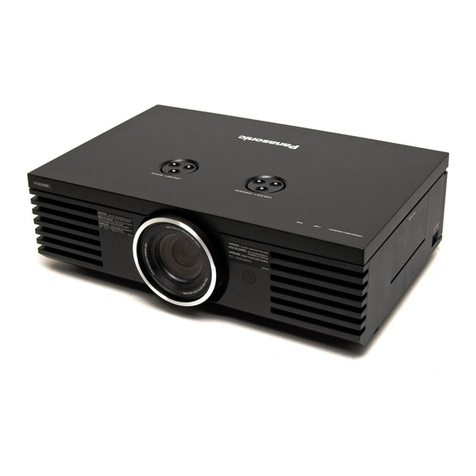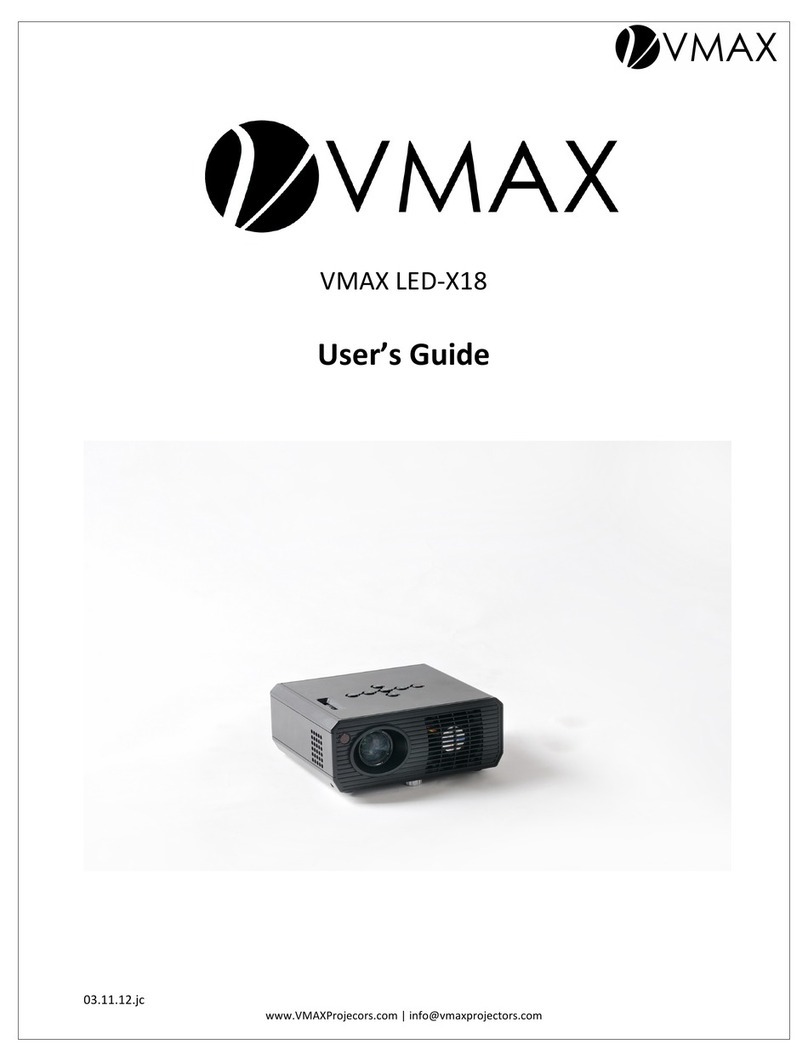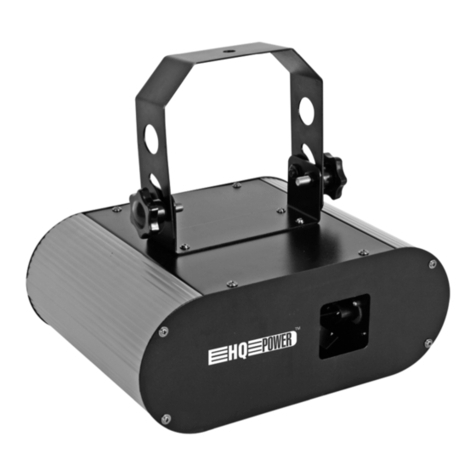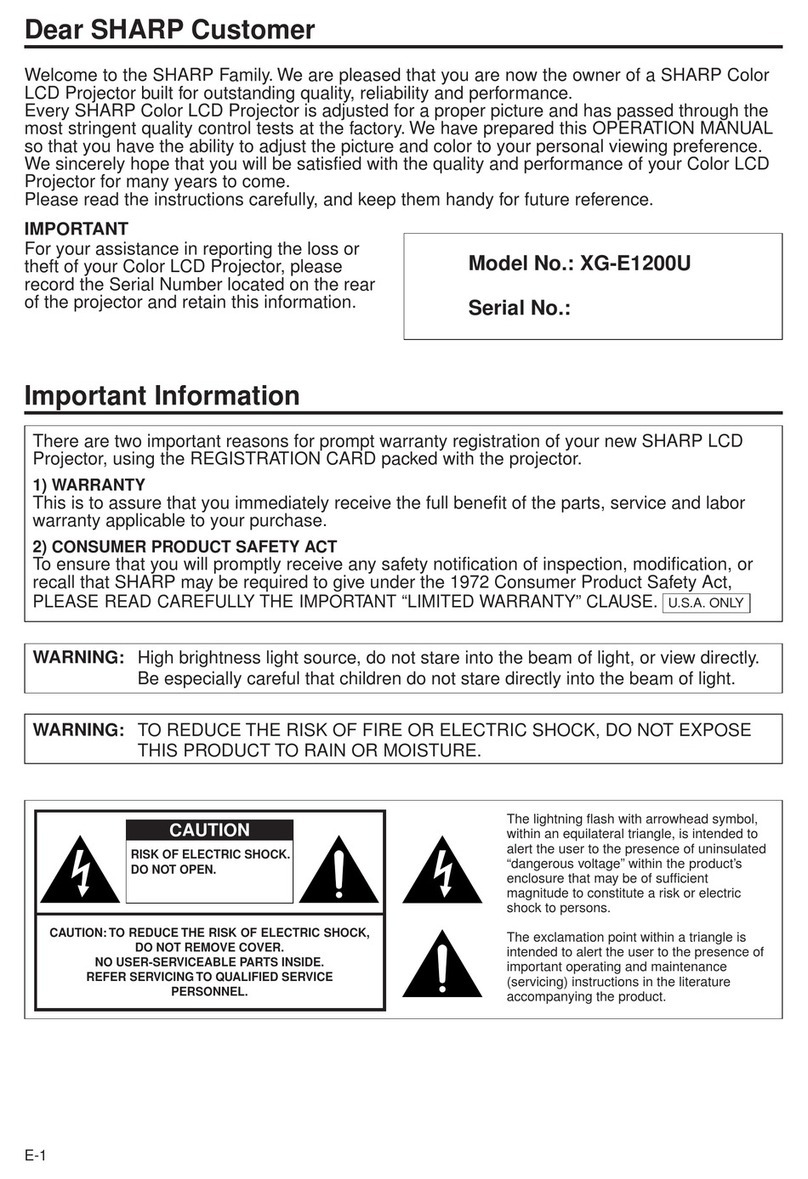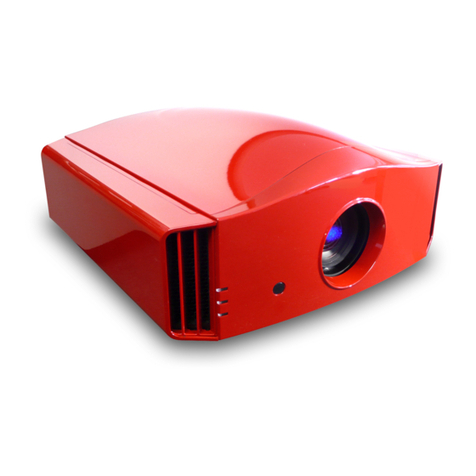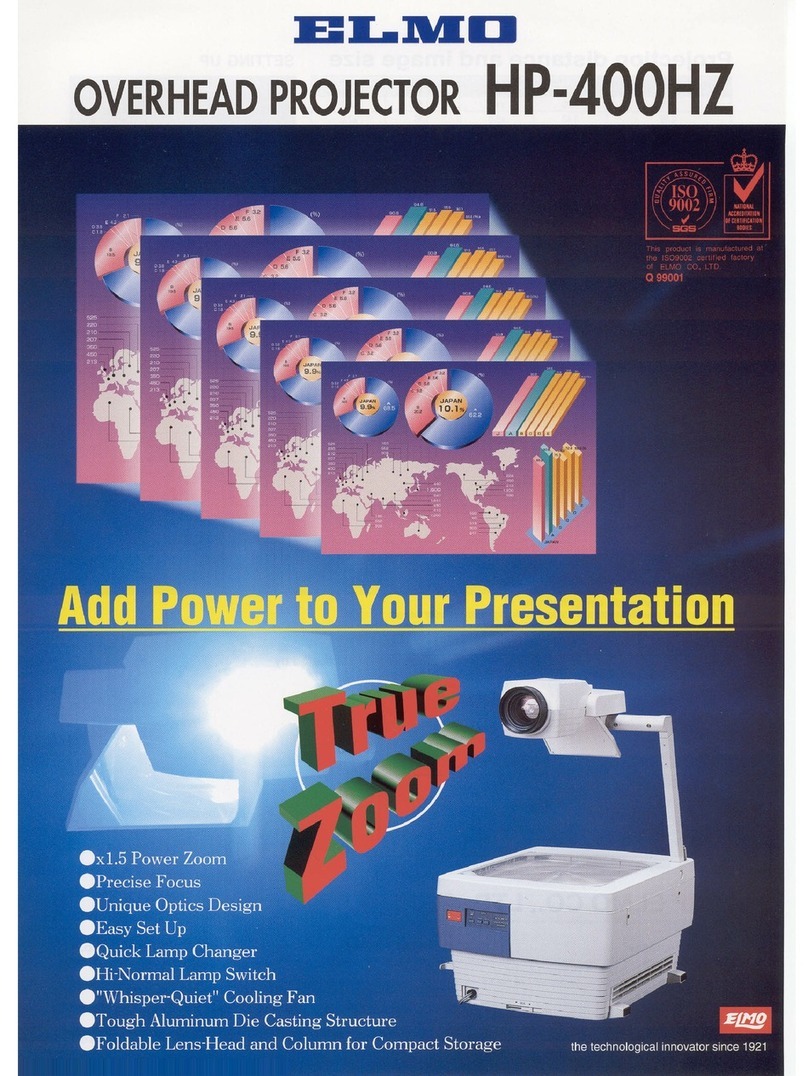Rosco Laboratories X-Effects User manual

Introduction 1
Modules 2
Base Unit 2
Wheel Module 4
Lens Module 6
Analog Control Panel 8
Preparing for Use 9
Assembling the Modules 9
Installing the Lamp (Base Unit) 10
Installing a Glass Pattern (Wheel Module) 11
Installing a Lens Barrel (Lens Accessory) 11
Unit Operation (Analog, Wheel, Lens) 13
Mounting 13
Powering Up 13
Adjusting Brightness 14
Adjusting Focus 14
Adjusting Wheel Speed and Direction 14
Adjusting Shutters on the Wheel Module 14
Warnings 15
Specifications 16
Mechanical Specifications 16
Electrical Specifications 16
Lamp Specifications 16
Wheel Module Specifications 16
Lens Module Specification 17
Warranty 17
MANUAL Rev 9/30/04 – Print 11/18/04

1
Introduction
Congratulations on your purchase of the Rosco Laboratories X-Effects
3-D Projector. This modular projector is intended to provide a range of
unique lighting effects with high brightness and in a compact package.
With the wheel module, these effects include, but are not limited to,
light reflecting off water and fire of varying intensities. A variety of
lenses provide a wide range of beam angles suitable for any situation.
In reality, the effects are limited only to your imagination. As more
expansion modules become available for the X-Effects, the
possibilities will only increase. Additionally, units currently fitted with
an analog control panel can be upgraded to a DMX control panel at a
later date.

2
Modules
Base Unit
The base unit contains the lamp, electronic ballast, first-stage optics,
and accessory power supply. The yoke attaches to the side of the base
unit in slots for positional adjustment. It also has a slot for special
optical filters.
N
ote: When handling the base unit alone, be careful of the front lens,
which extends slightly beyond the front plate and is subject to being
scratched.
Yoke
Yoke Tilt Knob
Cap Screw
Side View

3
Control
Panel
Fan
Line Connection
Lamp Indicator
Powe
r
Switch
Special
Optics Slot
Lamp
Lamp Clip
Lamp
Gk
Top
Lid
Back View
Top View (Lid Removed)

4
Wheel Module
The wheel module is made up of motors for rotating two overlapping
patterns. It also has shutters and a slot for placing an E-size gobo.
Connecto
r
Alignment Pin
Motor Top Lid
Bottom Lid
Back View

5
Drive PulleyGlass Patter
n
Side
Shutter
Pull
Tab
Botto
m
Shutte
r
Idle Wheel
Front View
Gobo
Mount
Top Shutter
Side
Shutter
Front View
(with wheels)

6
Lens Module
The lens module provides the mounting for the various lens barrels. At
this time, there are barrels available in 19º, 30º, 50º, and 70º beam
angles. It provides screw focusing and a lockdown knob. The lens
barrels themselves also have a slot for inserting a dichroic filter.
Plastic Cover
Cover Loc
k
Ring
Thumb Screw
Knob
Front View
Front View (without cover)

7
Dichroic
Glass
Ring
Barrel
F

8
A
nalog Control Panel
The analog control panel has all of the panel controls and electronics
for controlling the dual-wheel module and controlling the electronic
dimming of the lamp.
Control
Power
Indicator
Speed
Mode
Switch
Speed
Adjustment
Brightness
Adjust

9
Preparing for Use
Assembling the Modules
1. Unplug the unit.
2. [Optional] Install patterns and lens barrels as desired.
3. Place the base unit such that the front is facing you.
4. Take the wheel module and hold it such that the alignment pins
are facing the front of the base unit. Align the connector (if
present) with its mate and the alignment pins with their holes,
then push the wheel module onto the base unit. The plates
should be flush. Do not force the module if it does not seem to
work. Check for obstructions or bent pins.
5. Take the four long #-20 pan head Phillips machine screws and
insert them through the holes at the four corners of the front of
the wheel module. These screws thread into the base unit and
should be hand tightened.
6. Remove the plastic cover from the lens module by removing
the cover lock ring.
7. Place the lens module onto the front of the wheel module and
tighten in place with the three knobs on the front.
8. Replace the plastic cover and cover lock ring.

10
Installing the Lamp (Base Unit)
1. Unplug the unit.
2. Open the hinged lid on the top of the base unit.
3. Pull the lamp clip back away from the lamp gasket. Insert the
lamp so that the front of the reflector is seated in the lamp
gasket. The wire exiting from the front of the reflector should
be positioned in the cutout of the gasket. Release the lamp
spring clip to lock the rear of the lamp in place.
4. Attach the connector from the lamp to the connector in the unit.
It is a polarized connector and will only connect in one
position.
Wire
Cutou
t
Lamp Clip

11
Installing a Glass Pattern (Wheel Module)
1. Unplug the unit.
2. Unscrew the cover lock ring from the front of the lens module.
3. Remove the plastic cover.
4. Remove the lens module plate from the unit by loosening the
three thumb knobs on the front.
5. Look for the pull tabs on the plates with metal pulleys on either
side. These pull the plates outward for installing new glass
patterns. Once the plate is pulled outward, the pattern should be
inserted such that the metal ring sits in the groove in the rubber
drive pulley and in the 2 plastic idle wheels on the
corresponding side. Once in position, the pull tab can be
released.
6. Replace the lens module plate on the unit by lining up the
mounting pins, then tightening the three thumb screws.
7. Tighten the thumb screw by hand to hold the lens barrel in
position.
8. Replace the plastic front cover.
9. Replace the face lock ring on the front of the unit.
Installing a Lens Barrel (Lens Accessory)
1. Unplug the unit.
2. Unscrew the cover lock ring from the front of the unit.
Pull
Tab
Drive
Pulley
Metal
Ring
Idle
Wheels

12
3. Remove the plastic cover.
4. Remove the lens mount plate from the unit by loosening the
three knobs on the front.
5. Loosen the thumb screw on the lens barrel holding ring.
6. Remove the dichroic glass ring from the rear of the lens barrel.
7. Thread the lens barrel into the holding ring (CW screws it in).
8. [Optional] Place a dichroic filter in the rear of the lens barrel.
9. Replace the dichroic glass ring on the rear of the lens barrel.
10. Replace the lens mount plate on the unit by lining up the
mounting pins, then tightening the three knobs.
11. Tighten the thumb screw by hand to hold the lens barrel in
position.
12. Replace the plastic front cover.
13. Replace the face lock ring on the front of the unit.
Dichroic Glass Ring
Dichroic Filte
r
Thumb Screw
Lens Barrel
Knob
Plastic Cover
Cover Lock Ring

13
Unit Operation (Analog, Wheel, Lens)
Mounting
The yoke angle can be adjusted by loosening the tilt knob on both
sides of the unit. In order to slide the yoke back and forth in its track, it
is also necessary to loosen the cap screw at the pivot point. When
loosening the cap screw, it is strongly recommended to do this prior to
hanging the unit to minimize the risk of the unit falling.
The unit can be hung from any C-clamp or other mounting device that
uses a _” bolt. The three holes in the yoke are provided for this
purpose. The use of a safety cable is strongly recommended when
hung overhead. Also make sure not to block the top, bottom, or rear
vents when mounted.
Powering Up
1. Check to make sure that a lamp is installed.
2. Make sure the power switch is in the off position and the
hinged lid on the base unit is fully closed. Also make sure the
area in front of the lens is free of combustible materials.
3. Plug the unit in (check electrical specifications to ensure
compatibility).
4. Flip the power switch to the on position.
a. If there are no lights on the rear of the unit, check the
cord and the circuit that the unit is connected to. Also
check the fuse in the unit.
b. If the control panel lights, but there is no sound or lamp
light indication, check that the lid is fully closed (there
is a safety sensor on the lid).
c. If the control panel lights, and there is a ticking sound
accompanied by flashing of the lamp indicator, wait 30
seconds, then turn the unit off. Wait a couple minutes,
then try again. If it still does not work, the lamp may
need to be replaced.
d. If the control panel lights and the lamp indicator comes
on, then the unit is operating properly, but it will take a
couple minutes for the lamp to warm up.
5. Once the lamp is warmed up, the unit can be adjusted to suit
your needs.

14
A
djusting Brightness
1. Using a small flat screwdriver, turn the adjustment on the
control panel to achieve the desired brightness.
N
ote: Maximum electronic dimming range is 160-200W
A
djusting Focus
1. Unscrew the face lock ring from the front of the unit.
2. Remove the plastic front cover.
3. Loosen the thumb screw on the lens barrel holding ring.
4. Rotate the lens barrel to adjust the focus.
5. Tighten the thumb screw by hand to hold the lens barrel in
position.
6. Replace the plastic front cover.
7. Replace the face lock ring on the front of the unit.
N
ote: It is possible for the lens barrel to come in contact with a pattern
while focusing. Do not force the lens barrel if it stops moving or
encounters resistance. Proper rotation of patterns may require the lens
to be backed off a bit.
A
djusting Wheel Speed and Direction
1. The switches on the control panel will select between 3 speed
modes: Off, Slow, and Fast. One is for each wheel.
2. Turn the control panel knobs to fine tune the speed. One is for
each wheel.
3. The potentiometer knobs can be pulled out or pushed in to
change the direction of the wheels.
A
djusting Shutters on the Wheel Module
1. Open the top and bottom hinged lids on the wheel accessory.
2. The top lid gives access to the top shutter.
3. The bottom lid gives access to the bottom and side shutters.
4. Close the top and bottom lids.

Preliminary Instructions for Using ROSCO X-Effects/DMX
DMX Control Module
The DMX Control Module allows basic manual and full DMX control of the X-Effects
and its accessories. While some of the panel controls (Power, Dimmer, and DMX OK)
are common to both manual and DMX modes, most are used only in a single mode.

Manual Mode
By turning DIP switch #3 ON, the module is placed into manual mode. This will
automatically turn the lamp on and open the dowser (if present). This mode also allows
manual control of the dual wheel accessory. The speed of the two wheels can be adjusted
by turning the two shafts near the top of the module (full CW is fastest speed, full CCW
is stop). The direction of the two wheels can be adjusted by changing the position of DIP
switches #1 and #2. Additionally, the brightness of the lamp can be adjusted by the shaft
near the bottom of the module with a small flat screwdriver (full CCW is 200W, full CW
is 160W).
Note that the DMX OK indicator will light if DMX is connected to the unit, even if the
unit is not in DMX Mode.

DMX Mode
By turning DIP switch #3 OFF, the module is placed into DMX mode. The unit can
then be part of a standard DMX control system. Standard male and female 5-pin XLR
connectors (pin 1 = Ground, pin 2 = Data-, pin 3 = Data+, pins 4&5 are not used by this
unit) are provided for easy connection. Furthermore, the unit has pass-through wiring for
easy daisy-chaining of multiple units. The DMX OK indicator will be lit if the unit is
powered up and receiving a valid DMX stream.
We recommend the use of a 120ohm termination at the end of the DMX cable run for
highest reliability and best performance.
The starting address of the unit can be set by the three rotary switches in the middle of the
module. Each switch gives one digit in of the starting address, either 1s, 10s, or 100s. If
an invalid address is entered (0 or 513-999), the unit defaults to using a starting address
of 1.
The unit uses 5-13 DMX channels depending on the accessories used. In the standard
configuration with Dowser and Dual-Wheel Accessory, it uses only 5 channels.
Additional channels are built into the system for future accessories. The table below
describes all functionality.

Channel
Function
Description
1
Command
0-44% (0-113) = No Action
45-49% (114-126) = All Home
50-54% (127-138) = Lamp On
55-59% (139-151) = Lamp Off
60-100% (152-255) = No Action
Commands will only activate if level is held for 3
seconds.
2
Dowser
0-100% (0-255) = Full Closed to Full Open
3
Wheel 1
0% (0) = Stop
1-100% (1-255) = 4.5-110RPM (linear)
4
Wheel 2
0% (0) = Stop
1-100% (1-255) = 4.5-110RPM (linear)
5
Wheel
Directions
0-25% (0-65) = Wheel 1 CW, Wheel 2 CW
26-50% (66-128) = Wheel 1 CCW, Wheel 2 CCW
51-75% (129-192) = Wheel 1 CW, Wheel 2 CCW
76-100% (193-255) = Wheel 1 CCW, Wheel 2 CW
6-13
Additional
Accessories
Exact function depends on accessories used.
Note that the lamp brightness function is not controlled by DMX. It is controlled in the
same way as in Manual Mode.
When the unit powers up in DMX mode, the lamp will be off and the shutter will be in
the closed position. If no DMX signal is detected, the system will stay in that state. If a
valid DMX signal is detected and the unit has finished homing, it will be fully
controllable as described above.
Troubleshooting
Power indicator will not light.
Check that unit is plugged in and turned on.
Check that the fuse has not blown.
Power indicator lights, but DMX OK indicator will not light.
Check that unit is properly connected to a DMX controller.
Check cabling.
Check DMX signal with another device.
Check that DMX cable run is properly terminated.
DMX OK indicator flashes erraticly and/or unit behaves erraticly.
Check that DMX cable run is properly terminated.
DMX OK indicator lights, but unit does not respond to commands.
Check that DIP switch #3 is in the OFF position.
Check channel addressing.
Unit seems to respond to DMX, but not with all functionality.

Check the mechanics of the missing functionality to ensure that all parts can move freely
and belts are properly in place.
If all else fails, the module can be slid partially out of the unit so that the connections can
be checked. The diagram below shows the location of key connections.
For the most part, connectors can be matched up to headers on the PCB. The only
exception is the relay and power headers, which are identical. The relay cable uses two
blue wires while the power cable uses a red/black combination.
Table of contents
Popular Projector manuals by other brands

Mitsubishi Electric
Mitsubishi Electric HC4900 Specification sheet
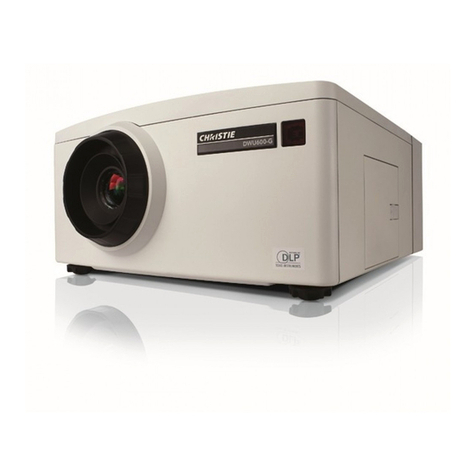
Christie
Christie DWX600-G Brochure & specs
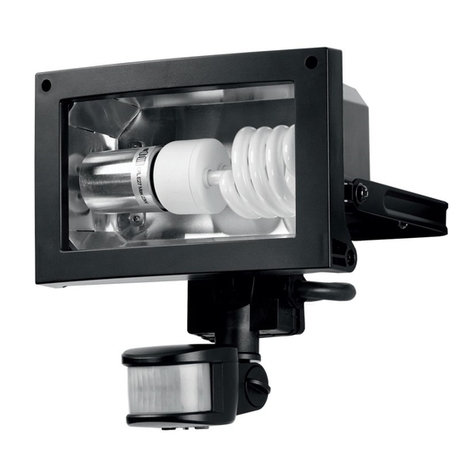
LIVARNO LUX
LIVARNO LUX LLES B2 User manual and service information
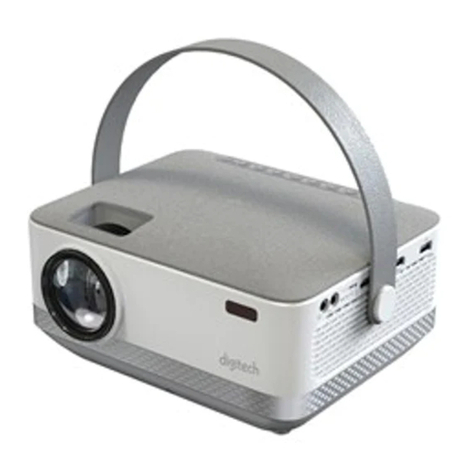
digi-tech
digi-tech AP4016 instruction manual
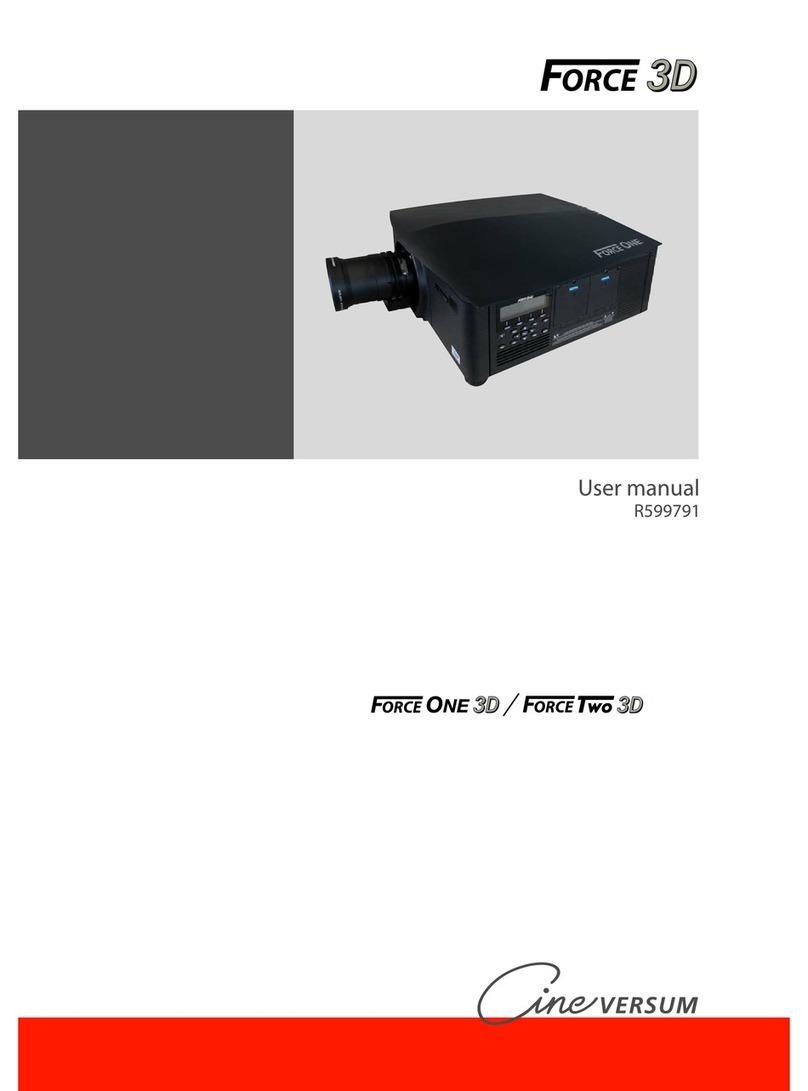
Cineversum
Cineversum Force One 3D user manual

Cineversum
Cineversum Blackwing MK2018 user manual
